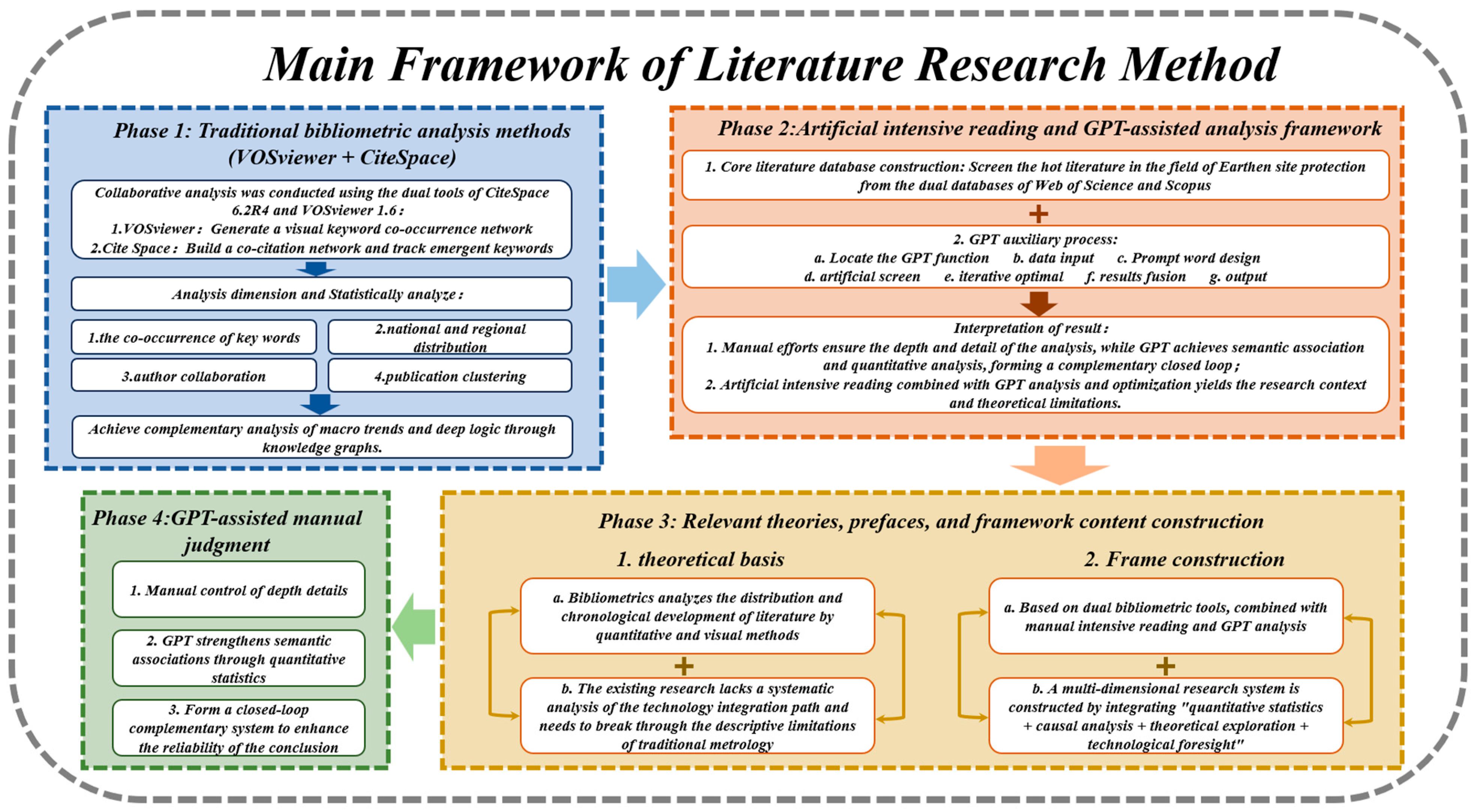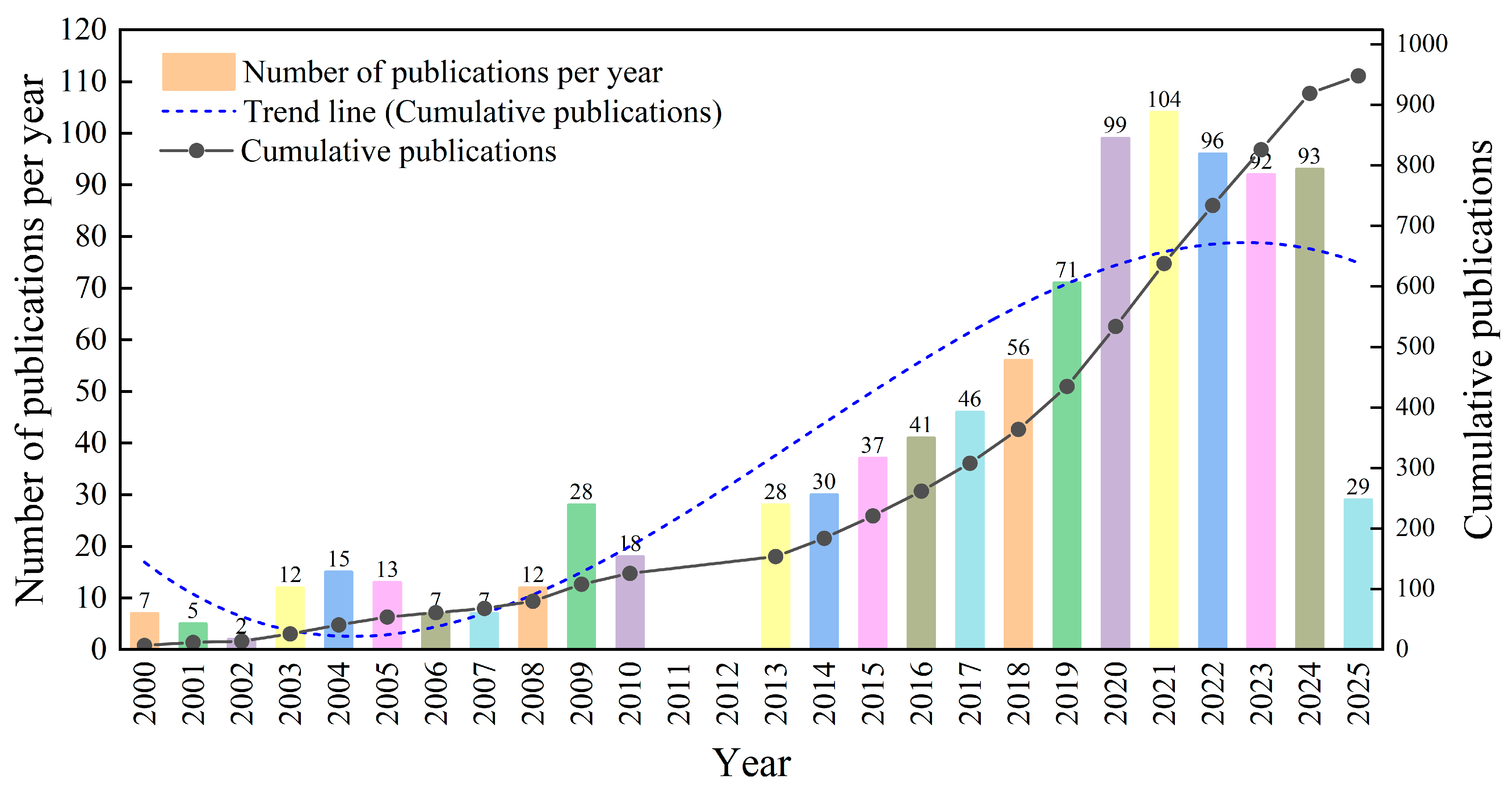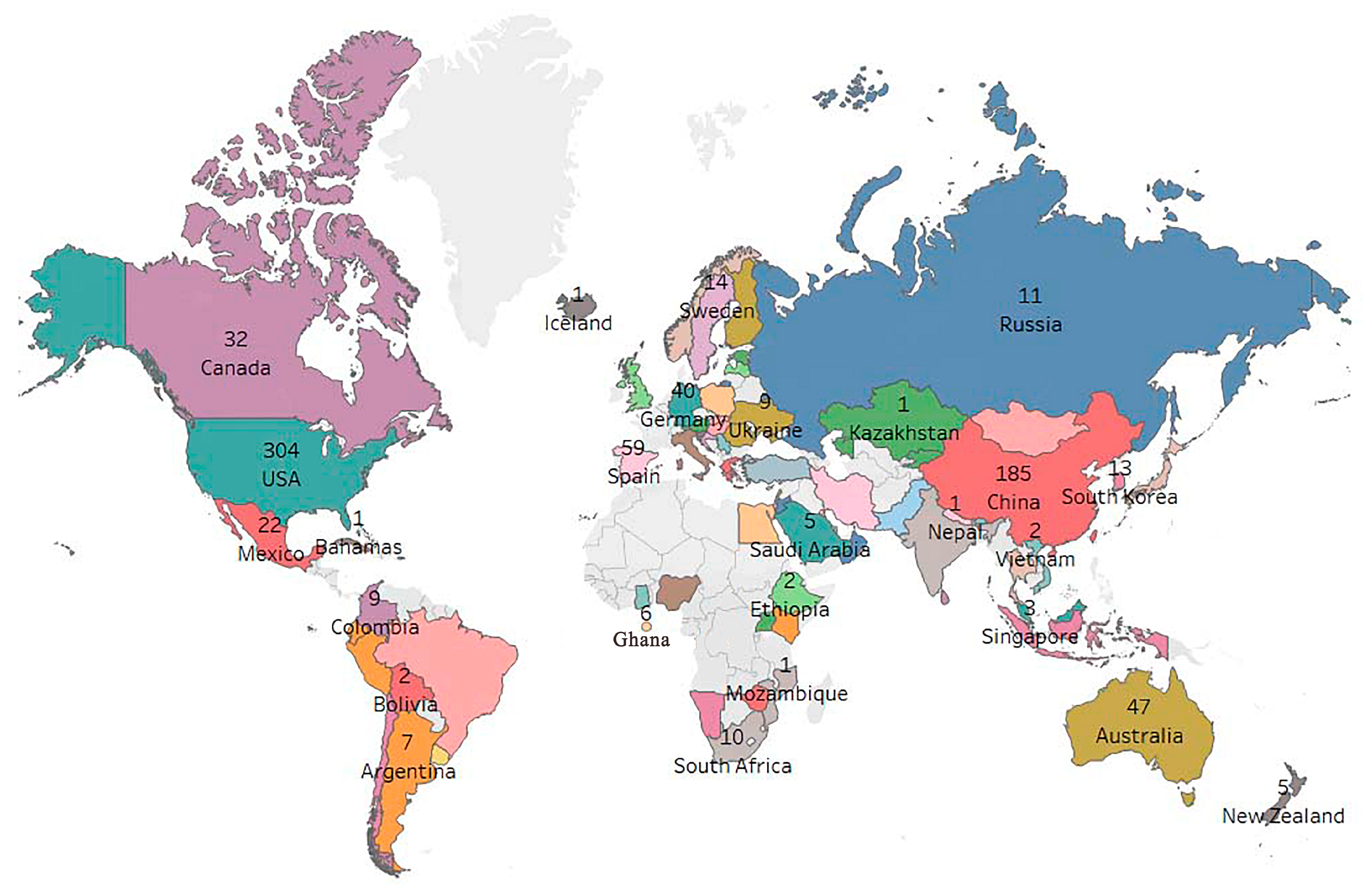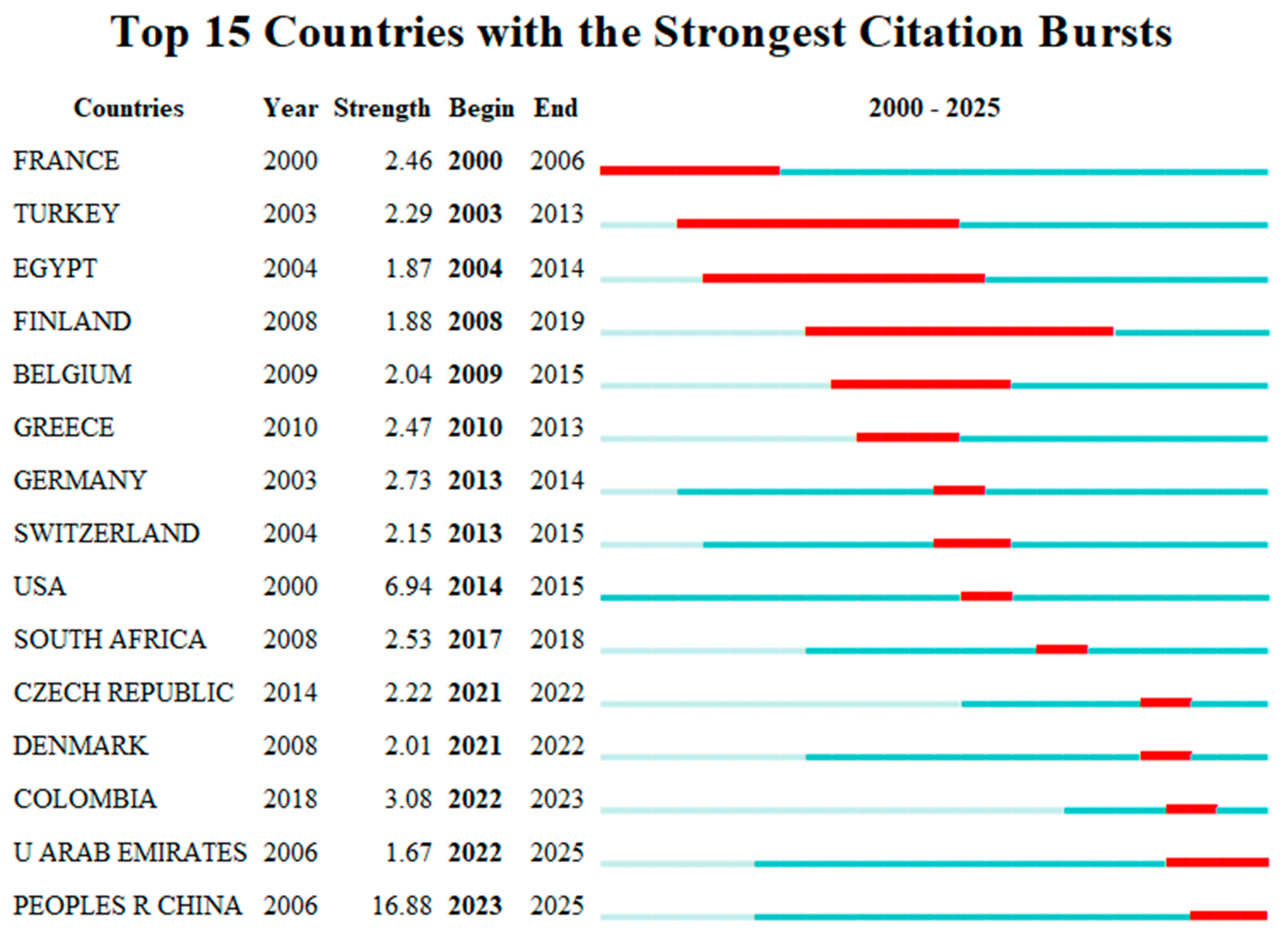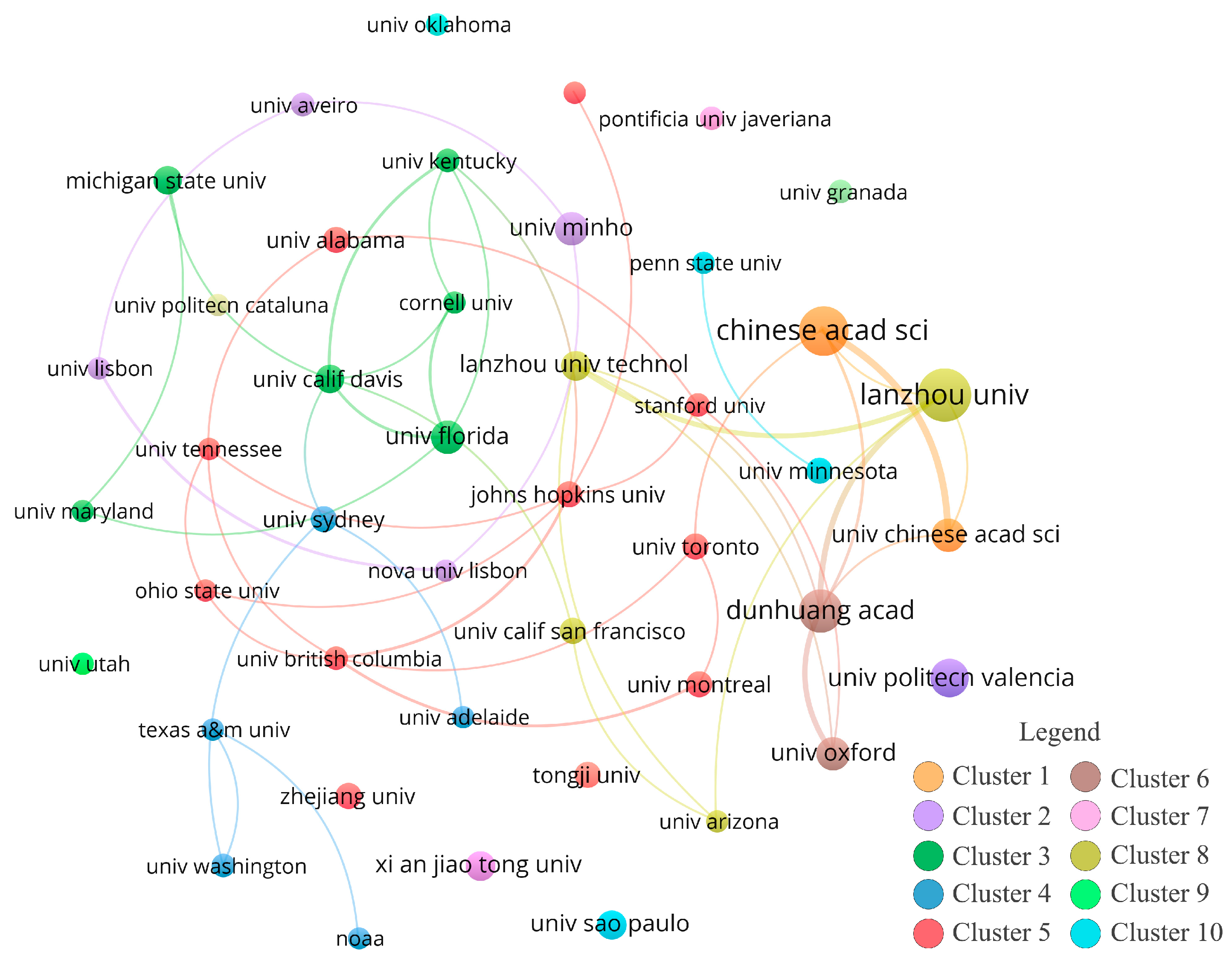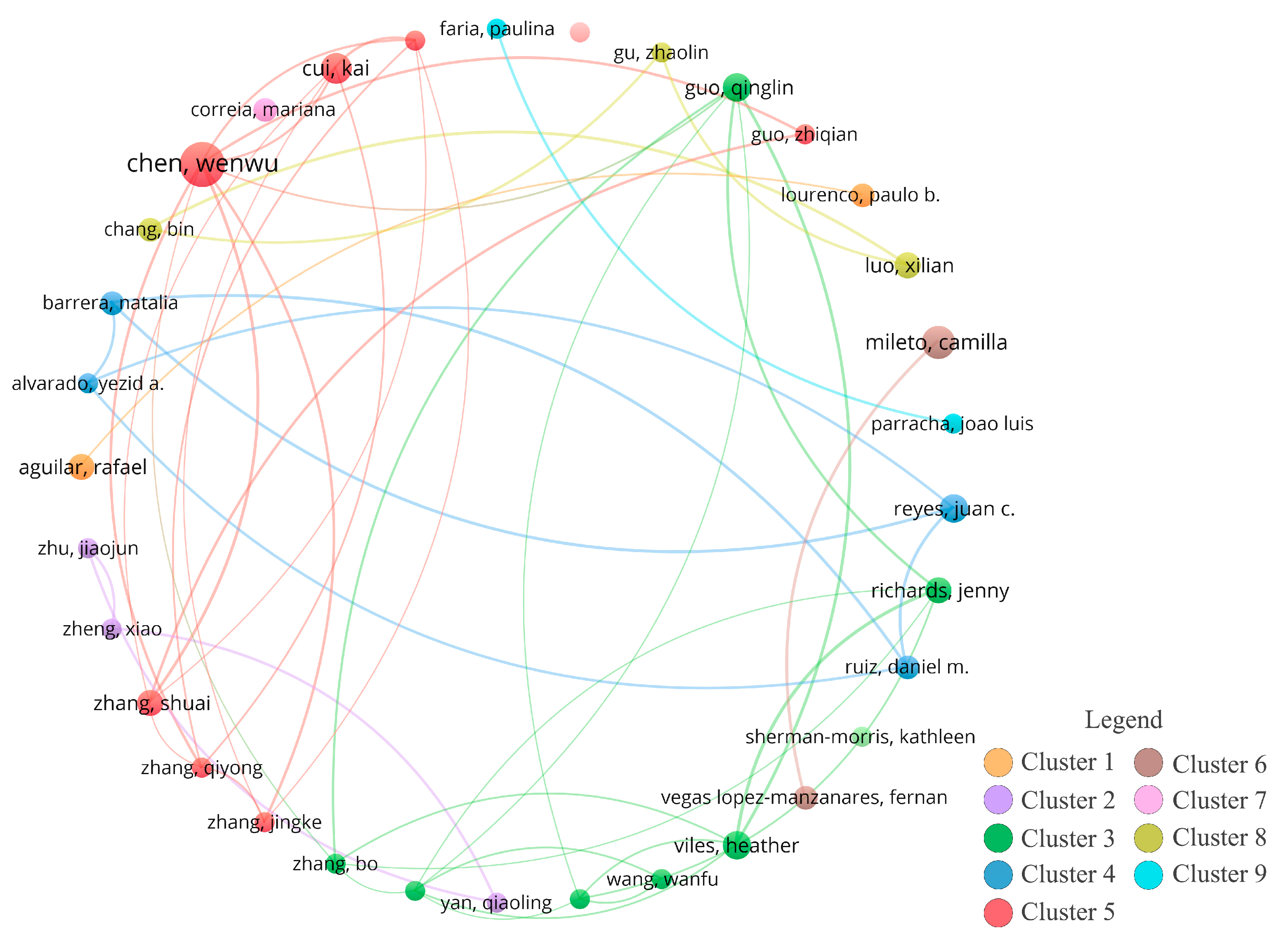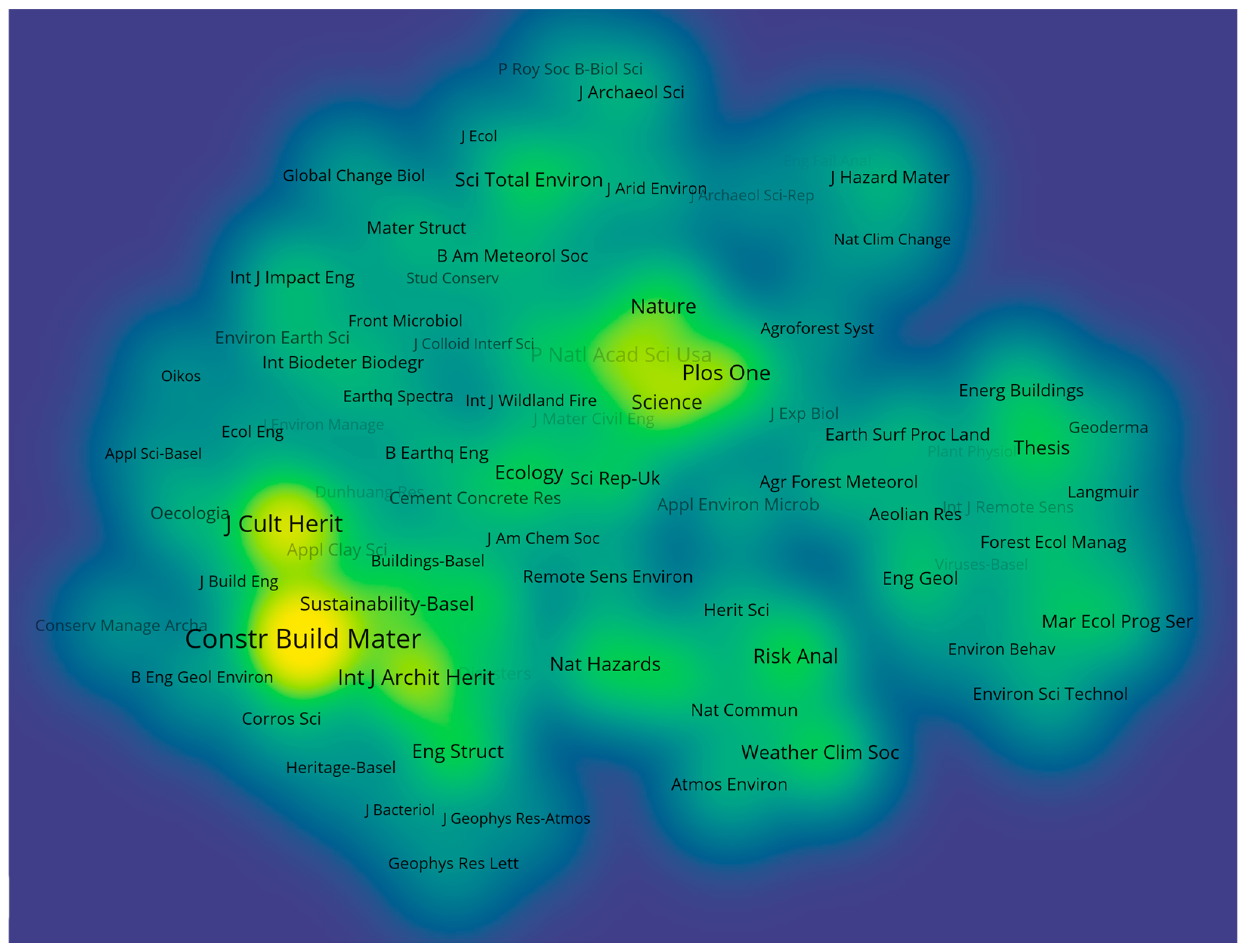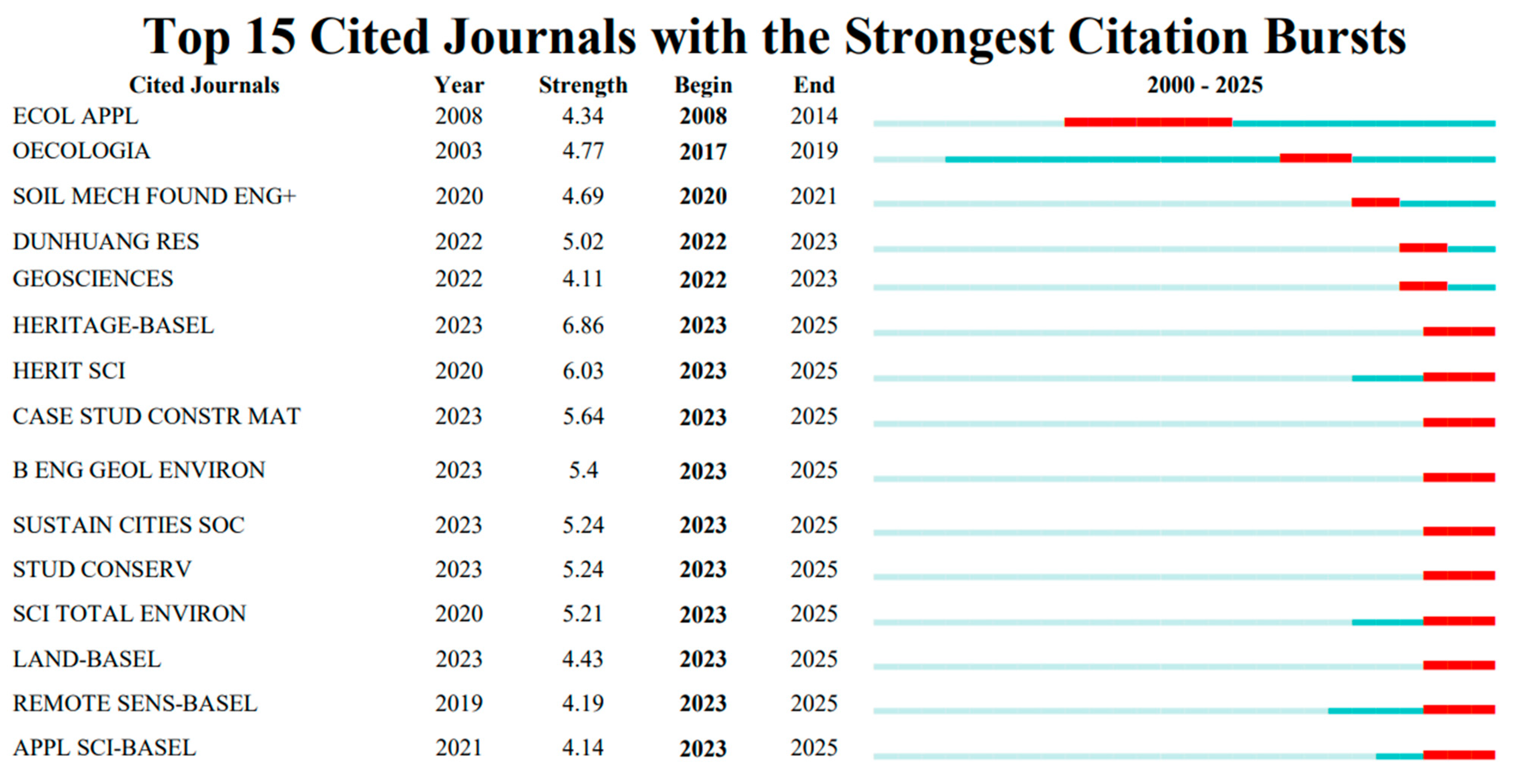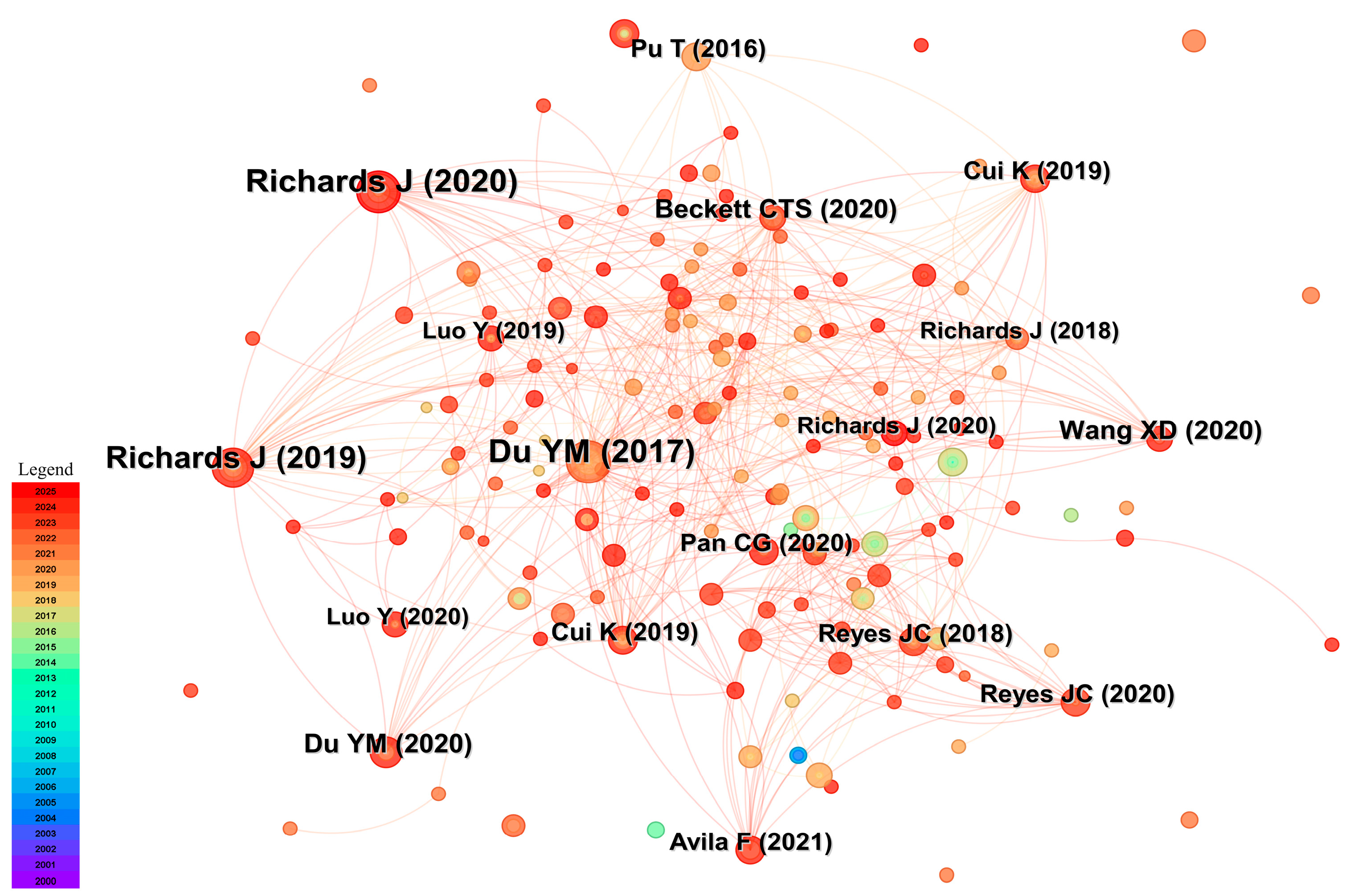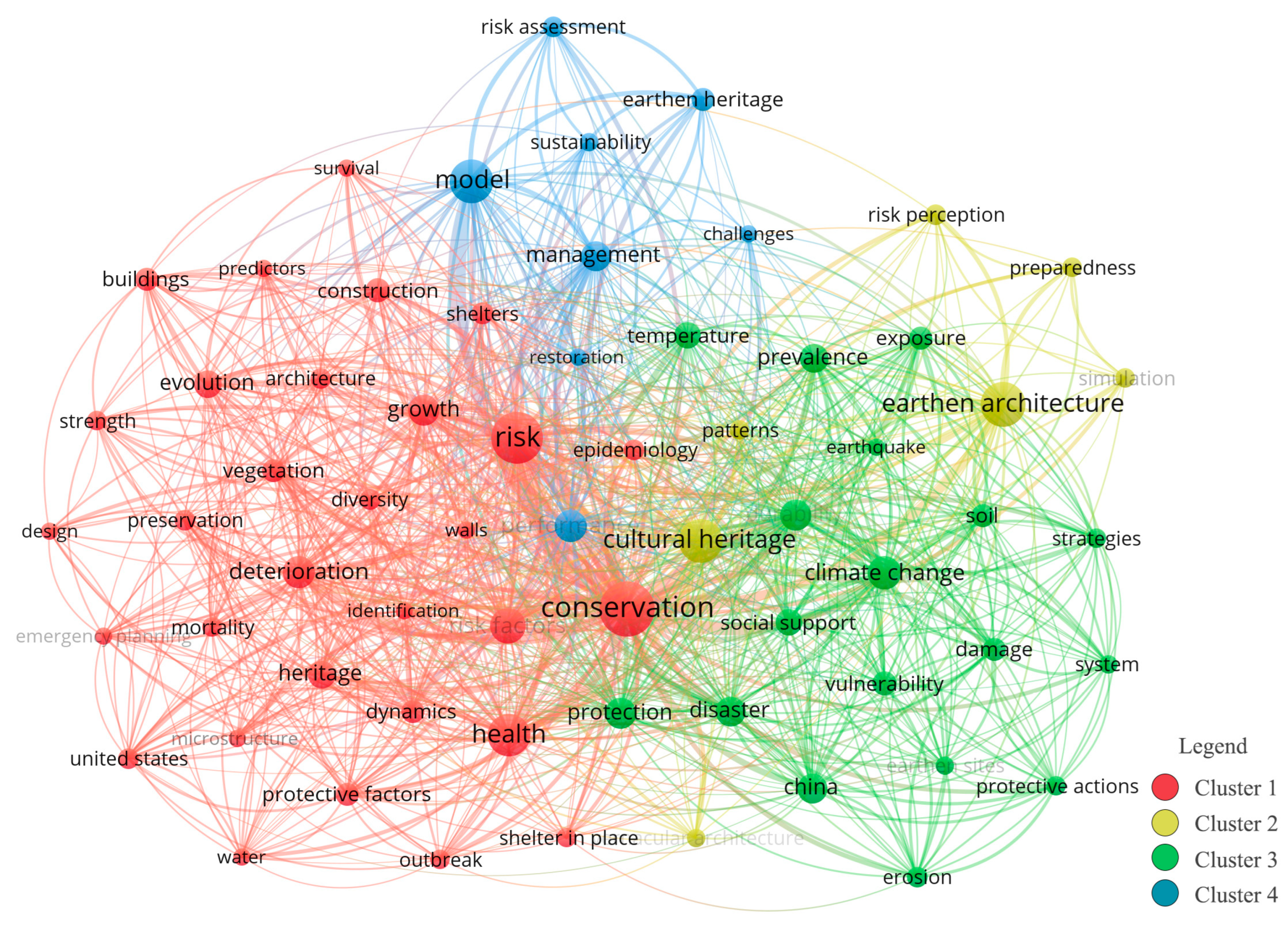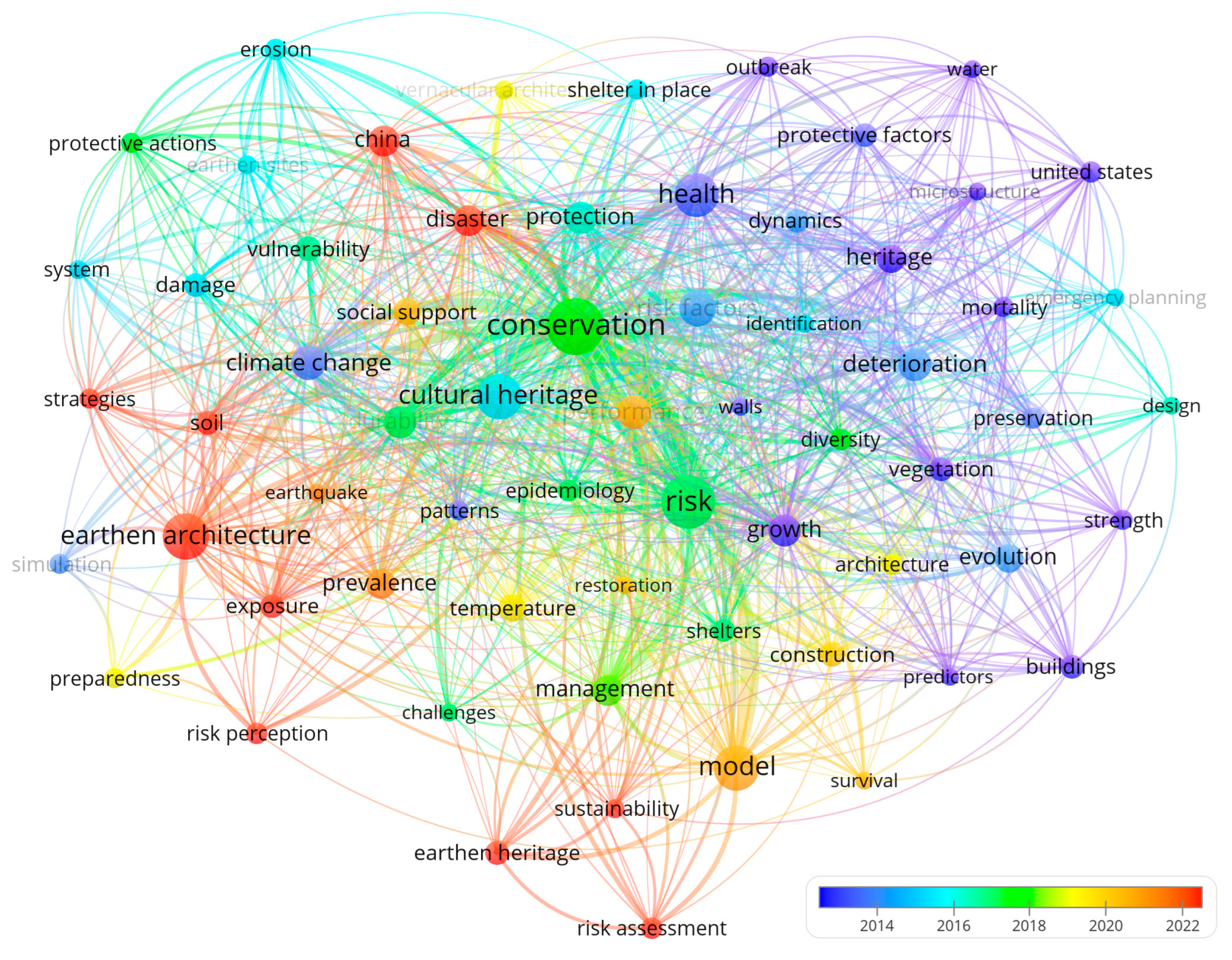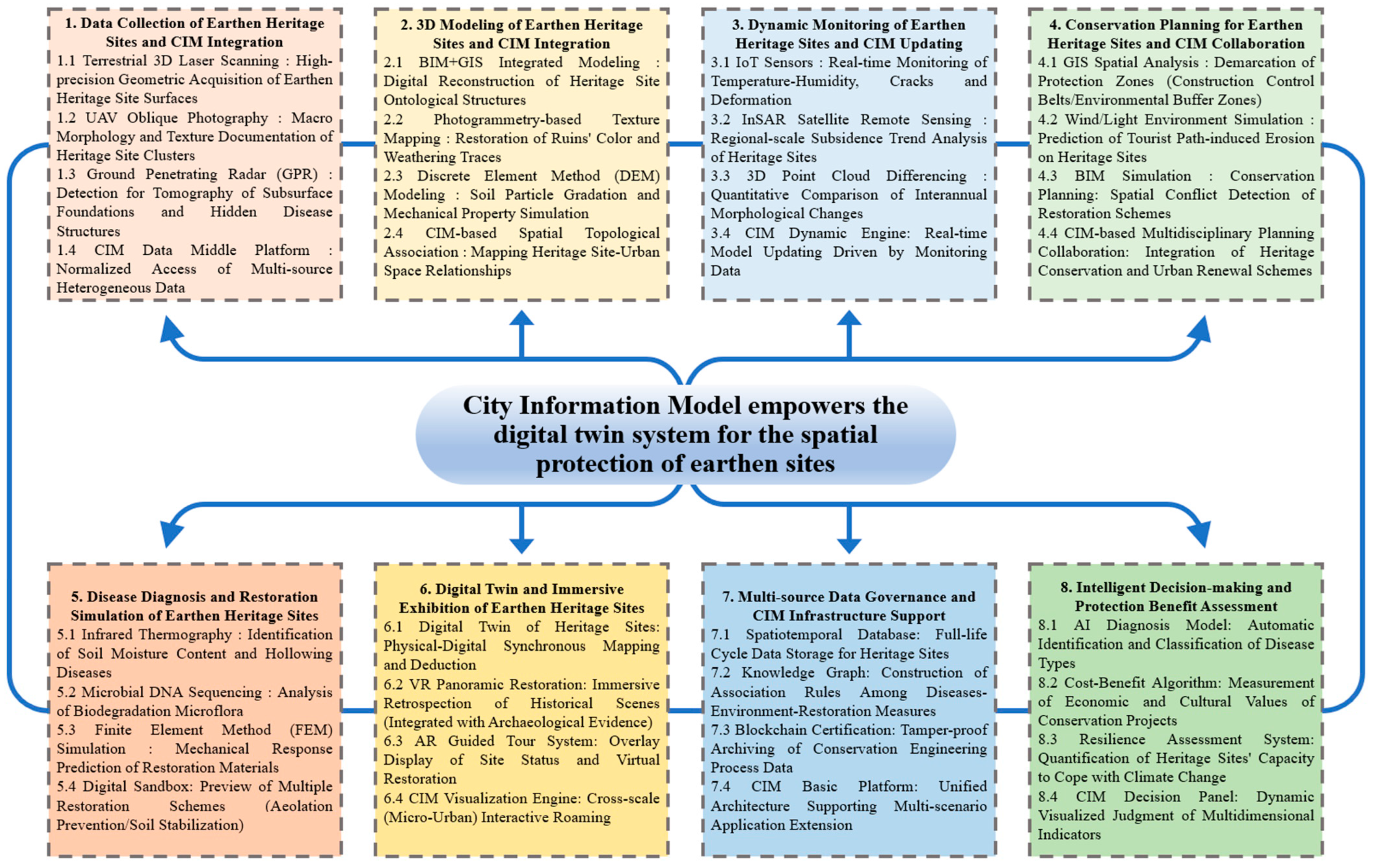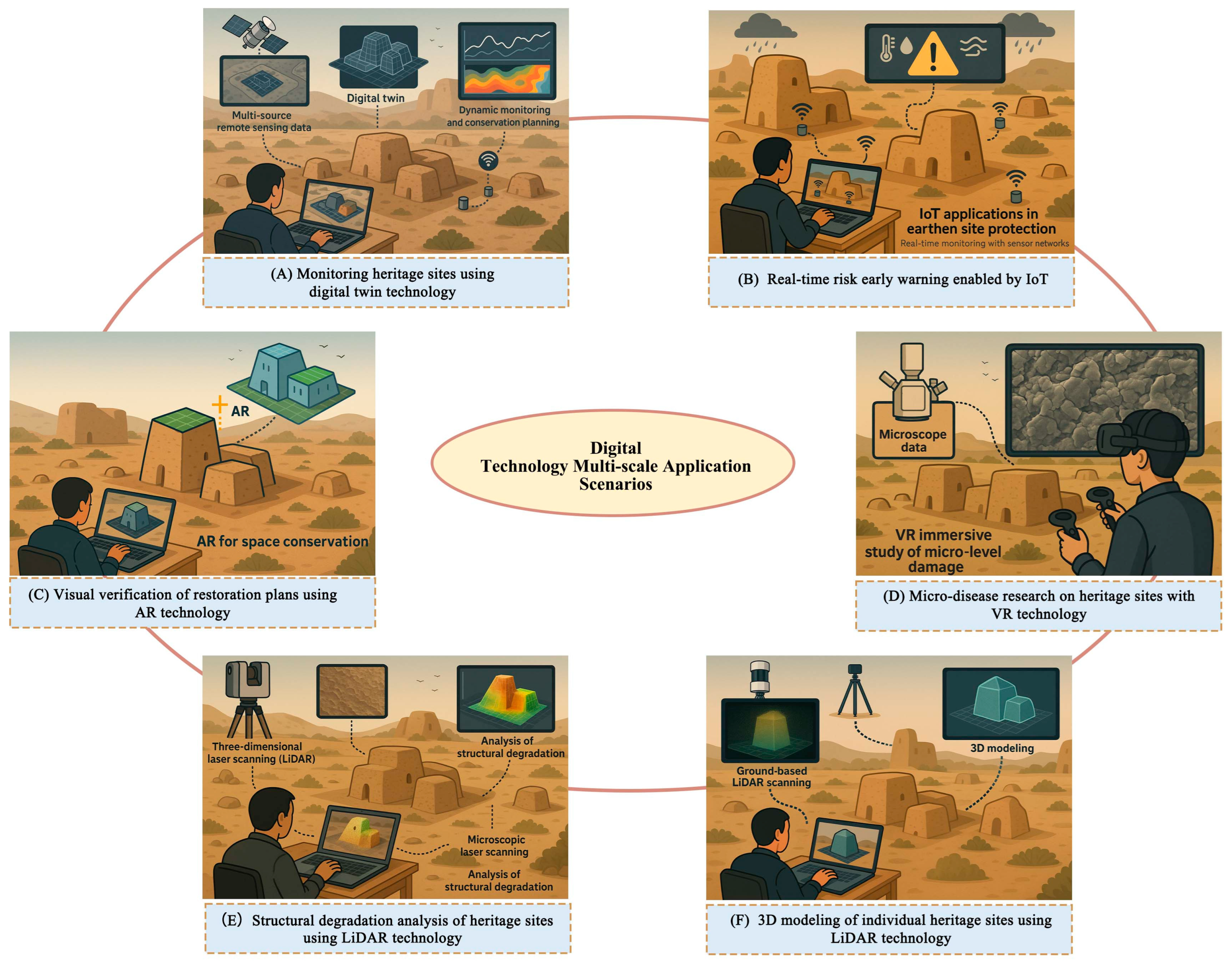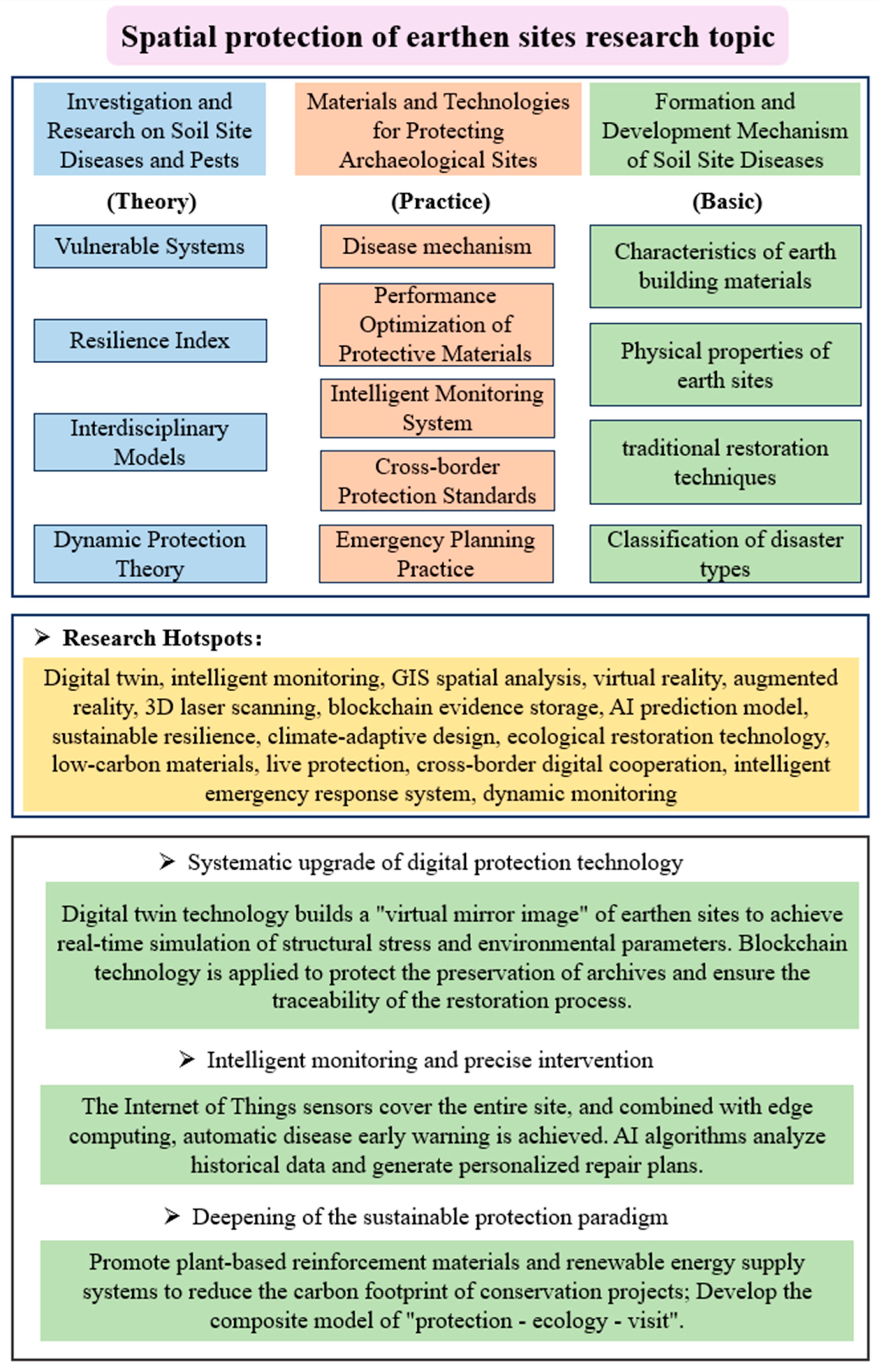3.1. Analysis of Annual Publication Trends
This study analyzes the publication trends in the field of earthen site surface conservation from 2000 to 2025, covering a total of 967 articles. As shown in
Figure 3, the research output has increased significantly over the last two decades and can be divided into three main stages: the initial stage, the transitional stage, and the rapid growth stage.
This study divides the development of research on earthen site surface conservation into three stages, with the starting point of the growth phase being appropriately advanced to reflect the increasing volume of publications.
Initial Phase (2000–2007): During this phase, the number of journal publications was low, indicating that the field was in its infancy with a relatively stable cumulative growth rate. The overall publication volume remained limited, reflecting a slow development trend. Research efforts were still exploring and developing foundational theories and methodologies. At this point, there was no mature research framework or comprehensive theoretical system, and studies primarily focused on the basic issues of earthen site surface conservation with limited interdisciplinary integration.
Transitional Phase (2008–2014): This period witnessed moderate fluctuations in publication output, showing a trend of staged growth. By 2014, the cumulative number of publications had reached approximately 450. The increasing application of spatial technologies such as GIS and RS to earthen site surface conservation [
25,
52], the gradual introduction of heritage conservation policies, and the development of interdisciplinary research all contributed to the accelerated progress during this phase. It is worth noting that there was no significant publication output in 2011–2012. Researchers speculate that this gap may be due to a shift in focus; the early years (2008–2010) emphasized reinforcement techniques [
8], while the later years (2013–2014) focused on deterioration mechanisms [
15,
53]. This two-year gap might represent a period of technical validation. Moreover, the widespread adoption of GIS and RS for conservation monitoring purposes occurred after 2014 [
54]; in contrast, the years 2011–2012 were still dominated by single-discipline studies (e.g., archaeology, material science), resulting in fragmented publications without prominent research hotspots.
Rapid Growth Phase (2015–present): Since 2015, the number of annual publications has consistently increased, peaking at 104 in 2021. The cumulative number of publications has shown an exponential upward trend, reflecting the growing attention to this field. The surge in research can be attributed to the rise of digital conservation [
55,
56,
57], the growing emphasis on sustainable conservation practices, and the promotion of international cooperative projects (e.g., UNESCO’s Asia–Pacific heritage conservation initiatives [
58]). These developments highlight the fluctuating nature of research activities over time and validate the delineation of the three stages.
Under the implementation of global heritage digitization strategies [
59], advances in artificial intelligence [
60], and especially the promotion of conservation work at earthen sites along the Belt and Road Initiative [
15], research on earthen site surface conservation is expected to yield more innovations in technology and sustainability. This field will likely remain a research hotspot for a considerable time, with increasing scholarly output in the form of papers and monographs.
3.2. Active Countries/Regions
The analysis of publication volume by country/region reveals the global distribution of research in the field, highlighting the necessity of strengthening international cooperation through scientific collaboration platforms. Such cooperation facilitates the global flow and exchange of knowledge and technology, ultimately enhancing the overall quality of research. As shown in
Figure 4, the global publication distribution map generated using MapBox 2025 v11.13.0 (
https://www.mapbox.com/ (accessed on 17 July 2025)) illustrates the number of publications by country through color coding and numerical labels. It can be observed that countries in North America, East Asia, Europe, and Oceania stand out with relatively high publication volumes, indicating strong research capacities. In contrast, countries in Africa, Central Asia, and South America generally show weaker research performance in this field, with some countries lacking data or having zero publications, resulting in blank areas on the map. And the publication gap between the United States (304 articles) and China (185 articles) may be influenced by the database’s preference for English-language literature, rather than reflecting an actual disparity in research capacity. In addition, data gaps in regions such as Africa are not examined in terms of whether they result from the limited distribution of earthen sites or a lack of research resources.
Figure 5 illustrates the top 15 countries/regions with the most significant citation bursts in the field of spatial conservation of earthen sites between 2000 and 2025. Citation burst analysis helps identify countries or regions whose publications have been cited intensively within a specific period, thereby indicating their rising influence in the field. Using CiteSpace, the analysis was conducted by setting the parameter to “Burst terms” to generate a burst detection map. A total of 15 countries were identified as having significant bursts. In this figure, Year indicates the first year that a country experienced a burst, while Strength denotes the intensity of the citation burst [
61]. The light blue bars represent the full time span (2000–2025), the red segments indicate the duration of the burst period, and years without significant changes are filled in dark blue. The analysis reveals that most citation bursts occurred between 2000 and 2015, reflecting a growing interest in surface conservation research during that period. In recent years, a new wave of burst countries has emerged—including Colombia, the United Arab Emirates, China, and Denmark—suggesting renewed global attention to the field. Among these countries, China experienced a burst from 2023 to 2025, with the highest strength value of 16.88, indicating a rapid ascent in global influence and a growing leadership role in the field. Although China shows the highest burst intensity (16.88) during 2023–2025, there is no comparison of the citation impact of journals between China and the United States, making it insufficient to assess international recognition based solely on burst intensity. In contrast, the USA had an earlier burst (2014–2015) with a strength of 6.94, confirming its early central position in the field but suggesting a tapering of global attention in recent years. Other countries such as Turkey, Germany, Greece, and Belgium experienced notable citation bursts between 2013 and 2020, demonstrating Europe’s early and solid research foundation in this area. Emerging research nations such as Colombia and the United Arab Emirates are gradually joining the ranks of high-impact contributors, indicating their potential to become major research forces in the near future.
Therefore, it is evident that China’s academic influence in the field of earthen site surface conservation continues to expand globally. The United States, on the other hand, demonstrates both strong international citation impact and a relatively high frequency of international collaboration, thereby exerting substantial global influence. These differences reveal that various countries have distinct understandings of the roles and developmental paths related to earthen site surface conservation. Overall, this analysis indicates that China is currently one of the countries conducting the most extensive research in this field, while also highlighting the academic interest, contributions, and recognition of research achievements from other nations. Future studies may further explore patterns of international collaboration and emerging research hotspots to support the sustainable development of this field.
3.3. Institutional Distribution Analysis
As shown in
Figure 6, the VOSviewer software was used to analyze the research institutions active in the field of earthen site surface protection. A minimum threshold of two publications was set to ensure the clarity of the co-authorship network visualization. In the resulting visual map, each circle and text label represents an institution. The lines connecting the circles indicate co-authorship relationships, with the line thickness reflecting the strength of the collaboration. Gradient colors indicate the overall intensity of cooperation with other institutions, and the size of each circle is proportional to the number of publications produced by that institution [
62]. Different colors represent distinct institutional clusters. For example, Cluster 1 includes the Chinese Academy of Sciences, Lanzhou University, and others. This cluster likely represents research forces centered on Chinese scientific research institutions and universities, mainly focusing on the theoretical foundations and material development for earthen site surface protection. Cluster 2 features institutions such as the University of Aveiro and the University of Minho, representing research groups from Portugal and other European countries that focus on techniques, methodologies, and protection management. Cluster 3, which includes several American universities, is likely oriented toward the use of advanced geographic information technologies and environmental monitoring techniques to observe and simulate the environmental conditions of earthen site surfaces. Connections between clusters show the presence of international collaborative research. For instance, the Chinese Academy of Sciences appears to collaborate with multiple international universities on research projects involving protective materials and monitoring technologies, including data and result sharing. In terms of institutional distribution, Chinese institutions dominate the field. The Chinese Academy of Sciences, Lanzhou University, Dunhuang Academy, and the University of Chinese Academy of Sciences are represented by relatively large circles, indicating a high volume of publications. The Dunhuang Academy, for example, has a high citation count (325 times) and an average citation rate of 17.1053, demonstrating significant academic impact. Lanzhou University has a relatively recent average publication year, indicating active and ongoing research in recent years. Domestically, institutions such as the Chinese Academy of Sciences and the University of Chinese Academy of Sciences, as well as Lanzhou University and Lanzhou University of Technology, are connected by thick lines, reflecting strong internal collaboration. Among international institutions, Michigan State University, Cornell University, and Stanford University have produced notable research outputs. However, their smaller circle sizes and thinner lines connecting them to Chinese institutions suggest a limited scale of international collaboration. The Chinese Academy of Sciences and Lanzhou University demonstrate close collaboration with dense linkages; however, the technological innovativeness and practical applicability of their joint research are not indicated. The sparse connections with overseas institutions are not analyzed in terms of whether they result from data-sharing barriers or insufficient international exchange. For example, Cornell University has an average publication year of 2012, indicating that its research activity peaked earlier and has decreased in recent years.
Figure 7 illustrates the top 20 most-cited institutions worldwide in the field of earthen site surface protection from 2000 to 2025. Notably, early research was predominantly led by US institutions—such as the United States Department of Agriculture and the University of California System—which laid the theoretical groundwork for the field. In the mid-term period, European institutions such as the University of Minho and Universitat Politècnica de València became prominent, focusing on the expansion and application of new technologies. In recent years, Chinese institutions have experienced a rapid surge in influence. Lanzhou University (2019–2025) stands out with a burst strength of 5.15, ranking first in the world in the field of earthen site surface protection, significantly ahead of other global institutions. Both Xi’an Jiaotong University (2022–2025) and the University of Chinese Academy of Sciences (2022–2025) also demonstrate strong intensity and sustained research activity. This trend indicates that China has shifted from merely participating in the field to playing a leading and demonstrative role, establishing a certain degree of international discourse power in the realm of earthen site surface protection. Lanzhou University (burst intensity: 5.15) shows a high burst, but its core technological focus is not specified (e.g., whether it concentrates on earthen sites in arid regions of Northwest China), making it difficult to infer the universality of its technologies. The burst of Xi’an Jiaotong University (2022–2025) does not indicate its collaborative relationships with other institutions.
Overall, Chinese research institutions have become a vital component of the global academic community, characterized by high research output and strong internal collaboration. However, international cooperation with institutions abroad still requires further strengthening. Moving forward, it is essential to promote a more integrated and interdisciplinary collaborative mechanism between domestic and international research bodies to advance the global development of research in this field.
3.4. Analysis of Research Authors
To reveal the collaborative relationships among authors, a co-authorship analysis was conducted using VOSviewer, as shown in
Figure 8, with the minimum publication threshold set at two papers per author. This analysis generated a co-authorship network map for researchers in the field of earthen site surface protection. Each circle in the map represents an individual author; the larger the circle, the more frequently the author appears or the more actively they are involved. Lines between circles indicate collaboration strength—thicker lines suggest stronger ties and more frequent co-authorships. Different colors represent distinct author clusters, indicating tighter intra-cluster relationships.
For example, Cluster 5 consists primarily of Chinese scholars whose research focuses on domestic earthen site surface protection, particularly in areas such as crack disease prevention and reinforcement materials for earthen sites in arid regions of northwest China. These researchers possess a strong foundation in local studies and practical experience. Cluster 3, by contrast, may include scholars from the UK, the US, and other Western countries who utilize advanced monitoring technologies and geographic information systems in their research, emphasizing environmental monitoring and data analysis of earthen site surfaces.
The lines connecting different clusters reflect instances of collaboration across groups, facilitating knowledge exchange. For instance, expertise in site management and planning from one cluster can inform strategies in others, while practical findings on disease prevention in earthen structures may offer useful insights to international peers. The visualization highlights that Chinese scholars form the core research cluster, with authors such as Chen Wenwu, Guo Qinglin, and Cui Kai appearing as large, densely connected nodes, indicating strong influence and leadership within the field. International scholars such as Lourenço Paulo B. and Heather Viles have also made significant contributions; however, their connections with Chinese scholars appear sparse, reflecting a relatively weak international collaboration network.
Overall, while there remains substantial room to enhance global collaboration, the trend also reflects the rapid advancement and emergence of new academic forces in the field of earthen site surface protection worldwide.
Figure 9 displays the top 10 authors worldwide with the most significant citation bursts in the field from 2000 to 2025. The citation burst analysis identifies authors whose publication frequency or citation rate has increased markedly during a specific time period, helping to reveal the field’s core contributors, emerging research trends, shifting focuses, and evolving hotspots. The author with the highest burst strength is Alvarado, Yezid A., whose citation burst began in 2022 and lasted through 2023, with a burst strength of 2.18. His research during this period gained substantial attention within the academic community. The author with the longest burst duration is Aguilar, Rafael, who maintained a high burst level from 2015 to 2019. His work has had a long-lasting influence and significant impact on subsequent studies. In recent years, Zhang, Shuai has also emerged as an influential scholar in the field, with growing recognition and impact for his recent research. These findings indicate that research in the field is undergoing a period of rapid development, marked by the emergence of a new generation of influential academic contributors.
3.5. Journal Co-Citation Analysis
In VOSviewer, a hotspot density map (or “cloud map”) visually represents the distribution of research hotspots within a field by illustrating the co-occurrence frequency or association strength of entities such as keywords, documents, or authors through color gradients and density. Typically, the color scheme ranges from cool tones (e.g., blue) to warm tones (e.g., yellow), with warmer colors indicating higher co-occurrence frequencies or stronger associations, thus signifying core research hotspots in the field. Higher density—indicated by denser clusters of points—reflects more frequent co-occurrences, suggesting that the research themes in that area are more focused. In contrast, isolated keywords may represent peripheral topics or emerging directions. Clusters of varying sizes correspond to distinct thematic areas.
Figure 10 presents a hotspot journal density map in the field of earthen site surface protection. Analysis reveals that the
Journal of Cultural Heritage,
Construction and Building Materials,
Nature, and
Science exhibit high cluster density and occupy the core of the hotspot map, marking them as authoritative and influential journals within the field. However, top-tier comprehensive journals such as
Nature and
Science may exhibit high clustering intensity due to interdisciplinary reviews or research, rather than systematic contributions to surface conservation technologies for earthen sites. In contrast, specialized journals such as the
Journal of Cultural Heritage account for a larger proportion of publications on earthen site conservation, with a focus on core hotspots such as material development and monitoring technologies. Their role in technological leadership is weakened by the generalized representation of “hotspot clusters” in the diagram. Conversely, journals such as
Geophysical Research Letters and
Journal of Bacteriology exhibit lower cluster densities and are typically interdisciplinary in nature—related to geophysics or microbiology—with more indirect links to earthen site surface protection.
Heritage-Basel appears in a bright color and forms an independent cluster, reflecting its focus on international heritage protection and signaling an emerging trend in the field. Core journals identified in the visualization can serve as key sources for literature review, while newly emerging journals often indicate potential research frontiers. Overall, the journal hotspot map offers a clear overview of journal distribution, disciplinary structure, and development trends in the field of earthen site surface protection, providing a valuable reference for future research planning.
Figure 11 presents the top 15 most-cited academic journals from 2000 to 2025. The data show that
Heritage-Basel (6.86, 2023–2025) and
Heritage Science (6.03, 2023–2025) exhibit the highest burst intensities, indicating that these two journals have had the greatest impact on academic research in their respective fields during this period. This suggests that research on earthen site surface protection has become a central focus in recent years. Additionally, journals such as
Remote Sensing-Basel and
Geosciences have shown strong citation trends since 2022, reflecting the growing application and influence of remote sensing and geophysical technologies in the field of earthen surface protection. Their rising attention in academic circles highlights significant advancements in related studies. The strong performance of these journals demonstrates their critical roles within their domains, and the duration and intensity of their citation bursts underscore their importance in driving academic research and the dissemination of knowledge.
3.7. Keyword Co-Occurrence Cluster Analysis
Keyword clustering reveals the distribution and interrelations of various research hotspots, thereby reflecting the primary thematic focuses in the field of surface protection of earthen sites. As illustrated in
Figure 13, this study conducted a keyword co-occurrence cluster analysis using the VOSviewer software. By setting the minimum occurrence threshold to 30, a total of 155 keywords were extracted from 18,467 keywords, resulting in a clear and detailed visualization. In the map, each node consists of a circle and a label, where the size of the circle indicates the frequency of the keyword’s occurrence, and the thickness of the connecting lines represents the strength of the relationships between keywords. Different colors represent distinct research emphases, forming four separate clusters. This approach effectively highlights the domain’s key areas of interest and provides insight into the evolving academic trends and emerging themes in the surface protection of earthen sites.
Cluster 1 (Red) focuses on risks and health-related conservation of earthen sites. Keywords include “risk,” “health,” “conservation,” and “cultural heritage.” This cluster centers on the various risks facing earthen site surfaces and explores how to ensure their healthy survival [
33]. Emphasis is placed on the attributes of cultural heritage during protection processes, discussing how to balance risk response and heritage conservation, preserve traditional characteristics, and incorporate contemporary conservation approaches.
Cluster 2 (Green) centers on the natural environmental impacts on earthen site surfaces and corresponding conservation strategies. Keywords include “earthen architecture,” “climate change,” “soil,” and “erosion.” This cluster analyzes environmental factors such as climate change, soil conditions, and erosion that affect the surface of earthen sites and explores nature-based conservation strategies and interventions.
Cluster 3 (Blue) highlights the development of models and management systems for the surface protection of earthen sites, with keywords such as “model,” “management,” “sustainability,” and “earthen heritage.” This research cluster delves into the construction of quantitative models for surface protection and the establishment of scientific management systems, analyzing the driving mechanisms behind sustainable development and their implications for managing the surface conservation of earthen sites [
21].
Cluster 4 (Yellow) addresses risk perception and response strategies related to earthen site surfaces. Notable keywords include “risk perception,” “preparedness,” “simulation,” and “challenges.” This cluster emphasizes a multidisciplinary approach to understanding public and professional perceptions of risks to earthen site surfaces. It examines the challenges through simulation methods and explores preparedness strategies, offering comprehensive approaches to enhance the effectiveness of surface protection for earthen sites.
However, there is a lack of representation for cross-disciplinary technological domains. For instance, “climate change” in the green cluster and “sustainability” in the blue cluster are connected by a relatively thin line in the diagram, which fails to reflect the strong causal relationship that exists in the surface conservation of earthen sites. Some cutting-edge technology keywords, such as DT, are absent from high-frequency clusters, resulting in a disconnect with the conclusions on “intelligentization” and “sustainabilization.” This may be due to the keyword filtering threshold (a minimum of 30 occurrences), which excludes emerging terms within the field and hinders the clustering results from capturing the trends of technological integration.
The keyword temporal frequency map (
Figure 14) illustrates the frequency and temporal distribution of keywords over time. The relationships among keywords help reveal thematic correlations within the research field and uncover the dynamics of academic development and emerging hotspots. In this visualization, each node consists of a circle and a label. The size of the circle is proportional to the frequency of keyword occurrence—larger circles and fonts represent higher frequencies. Lines between nodes indicate co-occurrence relationships, with line thickness reflecting the strength of those connections. The color of each circle, as indicated by the gradient legend in the bottom-right corner, represents the average year of occurrence. Blue indicates earlier appearance, while orange indicates more recent usage. For example, keywords such as “deterioration” and “heritage” are concentrated in the earlier, blue-colored region, reflecting early research interests. In contrast, keywords such as “sustainability” and “risk assessment” appear predominantly in the more recent, orange-colored region, indicating that they have become major focal points in the field in recent years.
This study reviews nearly 25 years of research on earthen site surface protection and proposes a five-phase model of the literature’s evolution based on the keyword co-occurrence frequency and the temporal distribution of emerging keywords. Although the time intervals of each phase differ, the distinct characteristics and varying rates of development effectively reflect the corresponding stages of research progress. The first phase (2000–2014), lasting 15 years, primarily focused on the attributes and characteristics of earthen sites themselves and the establishment of theoretical frameworks for surface protection through case studies. This phase marks the initial stage of research on earthen site surface protection, which is characterized by relatively slow development. In contrast, the third phase (2018–2020) lasted only 3 years, coinciding with a period of technological integration. The widespread application of GIS and RS technologies greatly accelerated the advancement of earthen site surface protection, making it more intelligent and precise.
Phase 1 (2000–2014): Key hotspots during this period include “Heritage,” “Cultural Heritage,” and “Risk Factors.” Research emphasized the cultural heritage value of earthen sites [
16], deepening the understanding of their significance from a broader heritage perspective. The foundational frameworks for protection and risk response were developed [
66], establishing theoretical underpinnings such as protection goals and risk classification, which later facilitated digital-technology-based research [
67].
Phase 2 (2014–2016): Keywords such as “Earthen Sites,” “Climate Change,” and “Vulnerability” emerged [
68]. This phase focused on refined analyses of earthen surface types and their correlations with climate change and vulnerability. The increasing attention to vulnerability mechanisms under environmental change marked a shift toward natural-environment-centered approaches to discovering new methods of surface protection [
69,
70].
Phase 3 (2016–2018): Hot keywords included “Conservation,” “Durability,” and “Management.” The visualization results show that “Conservation” remained central in the keyword network, continuing the core agenda from earlier stages. Protection during this phase emphasized scientific and systematic approaches, shifting from conceptual frameworks to assessments of practical effectiveness and long-term feasibility. The prominence of “Durability” reflects growing concern with material weatherability and damage resistance [
71]. The close linkage between “Management” and “Conservation” signals the transformation of theory into operational management systems, such as the development of risk assessment models or the incorporation of sustainable strategies addressing ecological, economic, and social dimensions [
72,
73].
Phase 4 (2018–2020): The key terms were “Model,” “Construction,” and “Architecture Evolution.” This phase signaled a transition toward practical implementation, with emphasis on applying surface protection technologies to real-world contexts. The emergence of “Model” indicated efforts to develop and apply quantitative models for dynamic simulations and data-driven decision making [
74]. “Construction” highlighted the use of new materials and techniques for surface repair and reconstruction [
75]. “Architecture Evolution” reflected studies on how natural and anthropogenic forces alter earthen site surfaces, while architectural and mechanical knowledge was leveraged to enhance conservation strategies, such as in situ preservation [
70,
76].
Phase 5 (2020–2025): Emerging keywords include “Strategies,” “Risk Perception,” and “Sustainability.” This phase centers on integrating various protection methods into comprehensive strategies. Greater attention is paid to understanding risk perceptions and advancing the sustainable development of earthen sites across ecological, economic, and social domains [
77]. The rise of “Sustainability” as a core keyword reveals a heightened emphasis on the synergy between long-term development and surface protection, echoing the field’s alignment with broader societal demands for ecological and socioeconomic sustainability [
78] and promoting the dual goals of cultural heritage preservation and environmental conservation [
79].
Figure 15 illustrates the top 15 most frequently cited keywords in the field of earthen site surface protection research between 2000 and 2005. Keywords such as “risk factors” and “cultural heritage” represent the academic focal points of that specific period. This analysis not only reveals the dynamic evolution of research hotspots across different stages but also reflects the shifting frontiers and focal themes within the field of earthen site surface protection. Among them, “cultural heritage” exhibits the highest burst intensity, with a rate of 4.7 during the burst interval of 2015–2021, indicating significant scholarly attention to topics related to cultural heritage in recent years. It is worth noting that there is an issue of term generalization regarding core concepts. For example, “cultural heritage” exhibited the highest burst intensity of 4.7 during 2015–2021, but it did not differentiate its proportion between earthen sites and other heritage types (such as stone heritage). As a distinctive type of heritage, earthen sites require targeted surface conservation technologies (e.g., rammed earth reinforcement, wind erosion control). The generalization of this keyword may obscure the lack of specialized technological research on earthen sites, leading to biased judgments on core issues within the field. In addition, keywords such as “earthen architecture” (2008–2025, burst intensity: 3.25) and “resilience” (2010–2020, burst intensity: 3.25) also show strong burst trends, highlighting major academic interest and activity within the domain. This trend suggests a global academic shift from the early focus on traditional risk factors to broader concerns regarding the relationship between large-scale sites and cultural heritage, as well as the development of long-term protection mechanisms. The emergence of these keywords not only underscores current research frontiers and hotspots but also helps scholars identify potentially significant future directions, such as in-depth studies around emerging keywords such as “heritage conservation” (2023–2025) and “earthen site” (2023–2025).
Based on the above visualization results, the research trajectory of surface protection for earthen sites can be interpreted through a dual-dimensional lens of temporal distribution and burst intensity. In the early stage, foundational concepts such as “Cultural Heritage” appeared early and maintained a strong citation burst (4.7), consistently occupying a dominant position. With theoretical advances and technological progress, keywords such as “Resilience” emerged in the transitional zone of the keyword temporal frequency map, accompanied by a notable citation burst, marking a shift from theory-oriented to practice-driven research. In the later stage, the term “Sustainability” becomes prominent in the frequency timeline, while “Heritage Conservation” and “Earthen Site”—which exhibit strong citation bursts from 2023 to 2025—act as complementary indicators. Together, these patterns suggest a developmental trajectory that moves from foundational studies toward a sustainability-oriented research paradigm.

